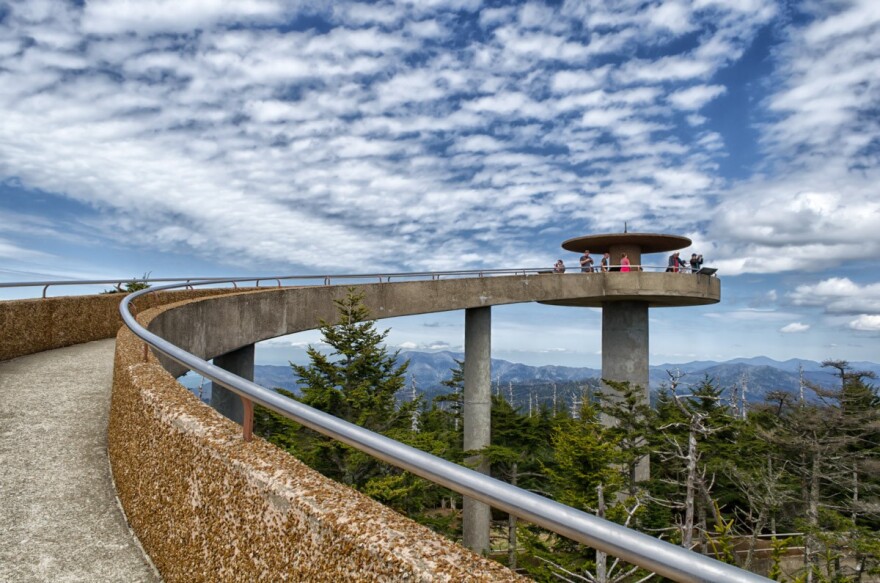In July, the Eastern Band of Cherokee Tribal Council voted to support a resolution to rename Clingmans Dome to Kuwohi – which translates to the Mulberry Place. Since then there has been growing support for the change. This week, Buncombe County Commissioners voted unanimously in favor of a resolution to support the Eastern Band’s efforts.
Eastern Band member and activist Mary Crowe told Tribal Council in July that what is commonly known as Clingmans Dome is important to the history of the Cherokee.
The mountain was named after North Carolina senator and Confederate brigadier general Thomas Lanier Clingman in 1859.
Crowe explained that Kuwohi is part of stories about the bear council, medicine men and more.
“We heard these stories - I’m trying not to cry – but boarding school took a lot of it away from us. My dad was a fluent speaker. That’s why I can listen and keep up with him but I have that solid conversation with him,” said Crowe at tribal council.
There were more than 400 boarding schools created by the U.S. government that forcibly took Indigenous children from their families. More than 50 of the schools have burial sites. The first study on these schools in America was released in May.
In Canada, over 4,000 children were killed at similar schools. The Pope of the Catholic Church visited the country last week to apologize for the church’s role in running the residential schools.

“We see [the renaming] as an avenue for our younger generation to learn and to relearn who we are as a people and that creator placed us here,” said Crowe.
During the meeting, tribal council members also brought up a number of other name changes and mispronunciations in the region.
Myrtle Driver, the Indian Clerk on council, explained that Judaculla Rock in Jackson County should be pronounced differently. The petroglyph is archeologically significant and part of a traditional Cherokee story about a giant.
Tribal Council member Bill Taylor also asked for an update on the renaming of Andrew Jackson Highway as U.S. 74 which runs east-west from Chattanooga, Tennessee to Wrightsville Beach, North Carolina. The highway was named in 1963, according to the NC DOT. One section in Roberson County was renamed to the American Indian Highway - that’s where the state-recognized Lumbee Tribe is located.
Buncombe commissioners support the name change
Buncombe County Commissioner Parker Sloan explained at the meeting that there is a need for community support to make a name change to the mountain.
“The ancestral name of this mountain has been passed down orally through generations despite the forced attendance at boarding schools where they were not allowed to learn about their culture or their native language,” said Sloan in the July meeting.
“To the Cherokee this mountain has always been called Kuwohi and they have asked us, the people of Buncombe County and our government, to join them in their efforts to restore the original Cherokee name of Kuwohi to the mountain presently known as ‘Clingmans Dome.’ Buncombe County applauds our Indigenous neighbors’ efforts and extends our sincere support,” Sloan said.
Commissioners said that their support echos the County’s acknowledgement that this land was first inhabited by the Cherokee, their ancestors, and other Indigenous peoples.
Part of that acknowledgement is an interactive digital webpage in 2021 published by the Buncombe County Register of Deeds office to highlight the history of how Cherokee lands were taken to form the county (including the maps and treaties from that time period). The website explains, “This land was acquired through violence, oppression, coercion and broken treaties.”
During the meeting, Commissioner Brownie Newman said that he received an email from Principal Chief Richard Sneed in support of Buncombe County’s resolution for the change.
Eastern Band member and activist Lavita Hill explained to commissioners that since the tribal council meeting, they have been working to better understand the history of the mountain.
“Just recently in a meeting with our elders, our speaker’s council who have determined that the correct spelling and pronunciation is Kuwohi,” said Hill at the Buncombe County Commissioners meeting.
The Buncombe commission then moved to change the spelling in the resolution from Kuwahi to Kuwohi.
The name change decision will ultimately be made by the U.S Board of Geographic Names and would be based in part on community support.







